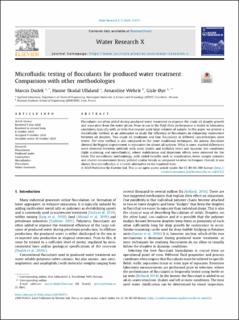| dc.contributor.author | Dudek, Marcin | |
| dc.contributor.author | Ullaland, Hanne Skudal | |
| dc.contributor.author | Wehrle, Amandine | |
| dc.contributor.author | Øye, Gisle | |
| dc.date.accessioned | 2020-10-30T07:34:34Z | |
| dc.date.available | 2020-10-30T07:34:34Z | |
| dc.date.created | 2020-10-29T08:47:22Z | |
| dc.date.issued | 2020 | |
| dc.identifier.citation | Water Research X. 2020, 9, . | en_US |
| dc.identifier.issn | 2589-9147 | |
| dc.identifier.uri | https://hdl.handle.net/11250/2685786 | |
| dc.description.abstract | Flocculants are often added during produced water treatment to improve the crude oil droplet growth and separation from the water phase. Prior to use in the field, their performance is tested in laboratory conditions, typically with jar tests that require quite large volumes of sample. In this paper we present a microfluidic method as an alternative to study the efficiency of flocculants on enhancing coalescence between oil droplets. Two crude oil emulsions and four flocculants at different concentrations were tested. The new method is also compared to the more traditional techniques. An anionic flocculant showed the biggest improvement in separation for almost all systems. What is more, marked differences were observed between methods with static (bottle and turbidity tests) and dynamic test conditions (light scattering and microfluidics), where stabilization and dispersion effects were observed for the latter. The microfluidic methodology, with added benefits such as visualization, lower sample volumes and shorter measurement times, yielded similar trends as compared to other techniques. Overall, it was shown that microfluidics is a viable alternative to the standard tests. | en_US |
| dc.language.iso | eng | en_US |
| dc.publisher | Elsevier | en_US |
| dc.rights | Attribution-NonCommercial-NoDerivatives 4.0 Internasjonal | * |
| dc.rights.uri | http://creativecommons.org/licenses/by-nc-nd/4.0/deed.no | * |
| dc.title | Microfluidic testing of flocculants for produced water treatment: Comparison with other methodologies | en_US |
| dc.type | Peer reviewed | en_US |
| dc.type | Journal article | en_US |
| dc.description.version | publishedVersion | en_US |
| dc.source.volume | 9 | en_US |
| dc.source.journal | Water Research X | en_US |
| dc.identifier.doi | 10.1016/j.wroa.2020.100073 | |
| dc.identifier.cristin | 1843147 | |
| dc.relation.project | Norges forskningsråd: 237893 | en_US |
| dc.description.localcode | This article is available under the Creative Commons CC-BY-NC-ND license and permits non-commercial use of the work as published, without adaptation or alteration provided the work is fully attributed. | en_US |
| dc.source.articlenumber | 100073 | en_US |
| cristin.ispublished | true | |
| cristin.fulltext | original | |
| cristin.qualitycode | 1 | |

